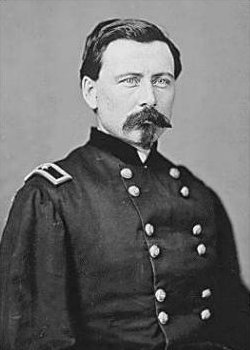Edward Winslow Hincks facts for kids
Quick facts for kids
Edward W. Hincks
|
|
|---|---|

Maj. Gen. Edward Hincks
|
|
| Born | May 30, 1830 Bucksport, Maine |
| Died | February 14, 1894 (aged 63) Cambridge, Massachusetts |
| Place of burial |
Mount Auburn Cemetery, Cambridge, Massachusetts
|
| Allegiance | United States of America Union |
| Service/ |
United States Army Union Army |
| Years of service | 1861-1870 |
| Rank | |
| Commands held | 3rd Division, XVIII Corps Army of the Potomac |
| Battles/wars | American Civil War |
Edward Winslow Hincks was an important American soldier. He served as a high-ranking general during the American Civil War. He was born on May 30, 1830, and passed away on February 14, 1894.
Contents
Early Life and Career
Growing Up in Maine
Edward Hincks was born in a town called Bucksport, Maine. His family name was originally spelled "Hincks." However, when he joined the U.S. Army in 1861, the letter "C" was accidentally left out. He started using the correct spelling again after he left the army in 1871.
From Printer to Politician
Before becoming a soldier, Edward worked as a printer. He helped make a newspaper called the Whig and Courier in Bangor, Maine. In 1849, he moved to Boston, Massachusetts. There, he continued to work in the printing and publishing business.
Edward also became involved in politics. In 1855, he served in the Massachusetts House of Representatives. This is where laws are made for the state. He also joined the Boston City Council in the same year. This council helps manage the city of Boston.
Serving in the Civil War
Joining the Union Army
In 1861, the American Civil War began. Edward Hincks decided to join the United States Army. He was first made a second lieutenant. This is a low-ranking officer position. But soon, he was offered a higher role. He became a colonel, leading the 19th Regiment Massachusetts Volunteer Infantry.
Fighting in Key Battles
Colonel Hincks and his regiment fought in many important battles. He was part of the fighting at Battle of Ball's Bluff. He also served in the Peninsula Campaign. During the Battle of Glendale, he was wounded. This means he was hurt in the fighting.
After recovering, he returned to his soldiers. He then fought in the Maryland Campaign. He was seriously wounded again at the Battle of Antietam on September 17, 1862. This was a very tough battle.
Becoming a General
Because of his bravery and leadership, Edward Hincks was promoted. He became a brigadier general of volunteers. This promotion was approved by President Abraham Lincoln. He officially became a general on April 4, 1863.
For the next two years, General Hincks had different duties. He sometimes served on a court martial. This is like a military court. He also helped recruit new soldiers for the army.
Leading African American Troops
In 1864, General Hincks was given an important command. He led the 3rd Division of the XVIII Corps. This division was made up entirely of United States Colored Troops. These were African American soldiers who fought for the Union. They were led by white officers.
General Hincks was one of the leaders in the First Battle of Petersburg. This battle was not successful for the Union at first. He also served during the long Siege of Petersburg. This was a very important part of the war.
Special Recognition
After the war, General Hincks received special honors. He was given the honorary rank of brevet major general. A "brevet" rank is an honorary promotion. It means you are recognized for your service, but you don't get the higher pay of that rank. This honor was for his service during the war. He also received a brevet brigadier general rank in the regular army for his actions at Petersburg.
Life After the War
Continuing to Serve Veterans
After the Civil War ended, Edward Hincks stayed in the army for a few more years. He served as a lieutenant colonel. In December 1870, he retired from the army as a colonel.
Even after retiring, he continued to help others. He became the governor of two different National Military Homes for Disabled Veterans. These homes cared for soldiers who were injured in the war. He worked in Hampton, Virginia, from 1870 to 1873. Then, he moved to Milwaukee, Wisconsin, where he served from 1873 to 1880.
Final Resting Place
Edward Hincks passed away in Cambridge, Massachusetts. He is buried in a place called Mount Auburn Cemetery. His grave can be found on the Eglantine Path.

